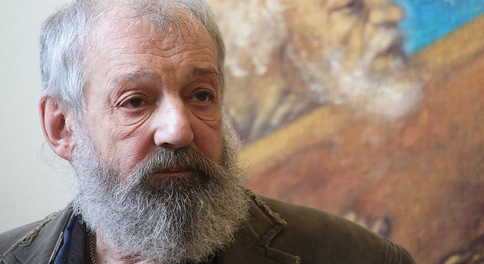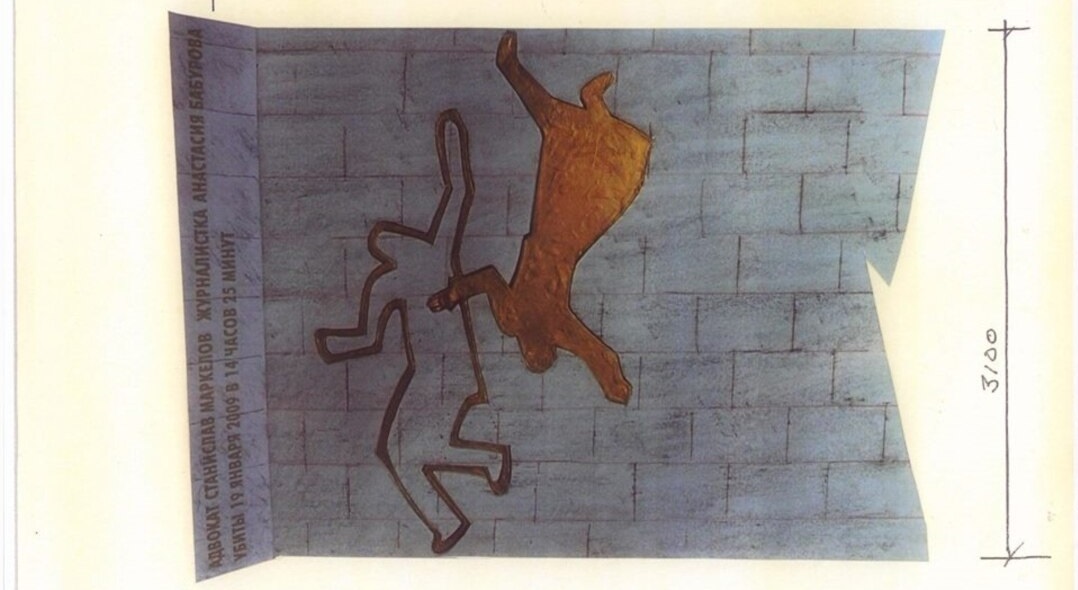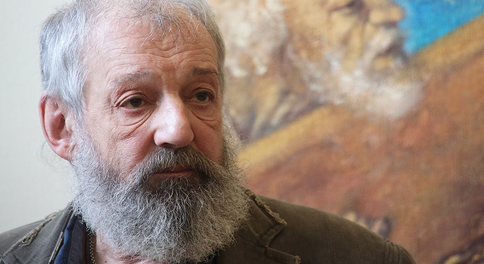Interview of sculptor Alexander Tsigal to Nezavisimaya Gazeta
31-10-2008

Author: journalist Alexandra Podolskaya
Monumentalism expressed in plastic
Sculptor Alexander V. Tsigal was born on June 21, 1948 in Moscow. In 1971 he graduated from the higher art industrial school (former Stroganovskaya school) where he specialized in sculpture. Since 1976 Alexander has been a member of the Union of Artists of the USSR. Since 1969 and up to the present he took part in more than 300 art exhibitions in Russia and abroad. Works of Tsigal are kept in many museums of the country (including the Tretyakov Gallery) and private collections of Italy, Bulgaria, Great Britain, Germany, the USA, France and Russia. He left his mark in the history of modern art as an author of monumental works, a creator of special plastic compositions and author of portraits both of his contemporaries and historical figures. Among his works: a figure-monument of St. George for the oval cupola on the building of Senate in the Kremlin (made together with his father, people’s artist of the USSR, winner of numerous state awards, academician of the Russian Academy of Arts, sculptor-monumentalist Vladimir Tsigal), sculptural composition “Angels” on the central gates of the eastern entrance of the restored Christ the Savior Cathedral, sculpture “Justice” for the building of the Russian Supreme Court (together with V. E. Tsigal), monuments to soldiers fallen during World War II (Yekaterinburg), miners of Ural; memorial plaques to academician V. P. Pfanov (Moscow), professor Konkin (Mytischi, Moscow region), writer V. Grossman.
Hereditary sculptor, academician of the Russian Academy of Arts, honored artist of Russia, winner of several awards, Alexander Tsigal is not a public person and while talking to someone he tries to avoid – as he says – “sliding to the social platform”. However he participated in the Day of Remembrance of the Victims of political repression at Solovetsky Stone in autumn 2007 and in the hunger-strike against the closure of the Moscow House of Sculptor in Spasonalivkovsky lane.
– Did that February hunger-strike in the House of Sculptor finally work?
– We were starving for five days (an average age of the participants was 67 years old, by the way). We were asked to stop starving from the president’s office – they did notice us. Recently in the company of Ivan Kazansky, chairman of the Union of Artists, and sculptor Vladimir Surovtsev, I was visiting a new minister of culture Alexander Avdeev. He promised to join us and said a good phrase: “We have to be superior to this situation, which seems to be an economic one, just through some volitional decision we have to keep the House of Sculptor to be for sculptors”. That is why we count on him. Some court cases are open, lawyer Tsvetkov works with a number of them. We do not know how it will end and do not play games of officials. Half of the house, that used to be ours, is still captured anyway. We do not know what is happening there now. The second half of the house is still used for exhibitions.
– Are chances to win the property dispute with officials good?
– It has nothing do with a property dispute, it is just nonsense! In any property dispute an official would win what he wants, it is all about his profession. It is banditry: we need the house, we are stronger and so we will get it. It is actually about attitude of the authorities to artists. On my 60th anniversary I was congratulated by Vladimir Putin. I sent him a response telegram where, under the acknowledgements, I wrote “I hope it is not only the recognition of my talent but also your good attitude to sculptors in general”. The House of Sculptor is a building with traditions, continuously functioning organism.
Today creative people are pushed away to the service industry – to work somewhere in between a dog barber and a masseur. The moral climate of the country is not created by someone’s official command, it is created by actors, artists and scientists. These people should speak and be listened to. But instead we have something understandable only by the people in power. There used to be understandable socialist realism reflecting their taste, now it is “glamorous realism” (the term of an art expert Natalya Sopova). But this taste is mostly typical for aesthetically unlearned people. No sculptures are made now, no songs are written, what they make are projects. So they have such a crap as consequence! Because it is accepted by non-professional people according to their bad taste and their false ideas of aesthetics. Therewith they seriously think upon closure of artistic unions. They have their own idea – they know how to make money. It is awesome! I don’t! Most of artists live poorly. But we live and do what we are good at, and finally history remembers only those people who were depicted in art. We know Medici thanks to the tombs of Michelangelo. When and under which terrible fever would anyone ever remember the grand inquisitor if not the great painting of El Greco? That man was a rare bastard and the Medici were nasty enough. Sculptor Yuri Chernov said an amusing thing: “Don’t bother the sculptor or nobody will ever make a gravestone for you”.
– You were born in the family of outstanding artists and have always lived in that world. Did you ever wish, being a youngster, to do something non-artistic?
– As long as I remember myself, I have always been pugging clay and drawing. I was kicked out from the classroom for drawing at a lesson of English instead of learning English, from the mathematics lesson – instead of studying math. We were sitting in the back row with my friend, drawing cowboy comics – we even had a special sketch-book. When I was ten, I was staying with my friend Peter Pommer (who later became a sculptor too) in the country, writing a thick novel about pirates and illustrating it. Two years after, when I was twelve, I illustrated books of Babel, Ilf and Petrov.
– The work “Destiny” is a complex and mysterious one. Whose destiny is it about?
– Nobody’s. We would wish it to be a wonderful lady, but she is peculiar for everyone. It is a kind of a creature, that drags you in an unknown direction, and you are going the wrong way, carrying some cactus or a geranium, and you think you have everything for happiness. And we often have wrong values and give a wrong definition to comfort. I do not come back to complicated and sophisticated ideas anymore. Now I try to put it simple and as short as possible. My hand is changing as well as the entire worldview. Only handwriting remains unchanged. What took two or three days (making a sketch, for example), now takes a week. I used to like painting portraits, sculpturing friends, now sculpturing someone from a portrait seems to be so difficult! Because that vision is gone. And there is nothing worse when being asked “Why have you made such a piece of crap this time?” an artist replies: “Well, you know, I was short of time so I did such a thing…” Bullshit! He just failed.
– Do you have any boundaries you never cross while sculpturing?
– There are some key phrases at different times pronounced by various artists – they determined the course I have been following through my entire life. Nolik Mitlyansky, whose slave I was in his shop during my studentship, taught me whom I could sculpt and who couldn’t (Those friends I used to sculpt deserved to be sculpted indeed. And, let’s say, comrades from the CPSU Central Committee deserved to be sculpted by comrades from the CPSU Central Committee).
Lyalya Bogushevskaya (wife of N. Mitlyansky) once said that sculpture did not grimace. But I let slip it away, of course. It came to my mind when I began overdoing things – I realized that grimaces had boundaries and when those boundaries were crossed, they were not sculptures anymore.
Father once said to me that every single thing had its own key. I did not understand what it was all about, had something more amusing to do then – drinking vodka or doing some careless stuff. But later I realized, that every sculpture had to be started as if you do it for the first time, and you would not repeat yourself and use the same methods. Finally you will be doing what you can do, not what you have seen in books.
– How can one avoid routine, if he works daily in his shop?
– It is very important where you participate and where you do not. I actually do not like the feeling of participation, but it automatically creates the feeling of responsibility and automatically creates irresponsibility. Finally the feeling of participation easily transforms into aggressiveness.
But anyway, despite the fact that sculpturing is a process of deepening, not staying on the surface, an artist participates in social life too. Nevertheless, recalcitrating against such things, I was given some social rewards. And It did not bother me too much. We are all conformists to some extent. Besides, any artist likes to be flattered.
– Do you care what other people say about your work?
– Well, just dare to estimate what I do! Try to say, for example: “It seems to me…” – I will explain everything to you, what I think about it; you will have enough for sure! What seems to you does not care me at all! But I do care about the opinion of some particular people. I am dreadfully sad, because the number of these people becomes smaller, some are already gone. And thank God, my dad is still here with me, I can always ask for his opinion. We disagree on many things, but he tries to understand from his own position what I am doing and he is sincere in his words, it is a rare thing for artists.
– Why?
– Because nobody wants to get under the skin of another creator with his own plastic arts. It goes like that – you do something and have your own mess in your head, and you are the only one who knows how to handle it. Should anyone really deal with this mess in your head? Of course, he does not want to, because he has his own in his head. Or does he have to say something based on his own mess about yours? It will probably sound like this: “Go f**k yourself! Don’t tell me what to do! Who do you think you are??” Just like a talk in a pub, you know…
– St. George on the Senate building has a spear, but one of your versions does not…
– One of my St. Georges really has no spear. But the coat of arms should have a spear. My earlier St. George did not have one. What is more important he points with a spear where good and evil are, he does not use it for killing. We forgot how to tell the good from the bad.
– Your bronze dog, devoted to humane treatment of animals, appeared at the subway station “Mendeleevskaya” following the history about a woman aged 20 who killed a dog named Malchik (Boy) with seven knife strikes. Does the cycle of works “Target” continue the story?
– The relative morality of time (in respect to еру absolute one) always has a backlash. As for our time, it is not even a backlash, it is a huge gap! Where did this dog come from? From the same place! It is the same target but made in a different way, but, in fact, it is the same stuff. “Target-people” – a continuous use of the mankind, absolute depreciation of a human life, today it is even despised.
One Italian communist was trying to explain me that killing of Gumilyov was a right thing, because he was an enemy. As for me, if all those communists were altogether poured with kerosene and burnt down, I would be the one to push them into this furnace with their own shovel and make them go to hell! If they do it with great people, what can be done with others?
This dog is kind of a sign. It symbolizes the attitude of those people who financed this thing, who come there and leave flowers. However, the sculpture has not changed the attitude of other people – those who still kill dogs and those officials who still cover this up.
– Your William Tell (from the cycle “Target”) resembles you in profile: a protruding nose and an earing. Gumilyov and Kharms have some resemblance with you too.
– When I sculpt someone – it represent this character and then he starts to live his own life. As for me, I come to a mirror and smile, if he smiles, and I laugh if he does. I pose the way he does to find out how it looks like in detail. I make faces and roll my eyes. I talk to the radio. Just like a madman! An artist cannot work when he is himself. This is how it goes: if you do nothing and stand up, it does not mean you stood up to go for bread, it could be just a part of the process: you stood up and lay down, then you came down to your shop and started sculpting, next you came outside. This entire process means making a sculpture.
I was surprised to find out from the interview of Chagall’s widow, that when the master began working, he behaved as if he was absolutely insane. I had always thought it was only my problem…



